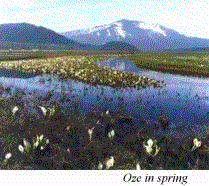

 |
||

|
Repository of Rare Plants and Animals
 Oze is at the center of a wetland area of lakes and marshes.
Located to the northwest of Nikko National Park, the surrounding mountains
straddle an area that includes parts of the three prefectures of Gunma,
Fukushima, and Niigata. Oze is a valuable repository of those flora and
fauna that live in wetland habitats. Such is its biological importance
that the whole area has been designated a Special Natural Monument.
High mountains, rivers, lakes and marshes, waterfalls, and wetland are all part of this rich and varied landscape. Characterized by high rainfall, Oze is home to a variety of plants and animals. At the center is Ozegahara, a broad flat area that is surrounded by primeval forest. Home to about 140 distinctive species of plant life, this is Japan's largest wetland in the mountains, covering an area of 8 square kilometers (3.1 square miles). The colony of the Mizu Basho (Skunk Cabbage) are particularly well known, and most sightseers come to Oze when the plants are in season from May to June. Many other attractive plants are to be found, such as the golden blooms of the Nikko Kisuge (Nikko Day Lily) in the summer or the beauty of the autumn leaves. Oze is also inhabited by various animals, including mammals such as the Nihon Kamoshika (Japanese Serow) and the Tsukinowaguma (Asiatic Black Bear), both Special Natural Monuments, over 100 species of wild bird, and more than 40 types of insect. The ecosystem could easily be damaged by the foot steps of the multitude of visitors who come to enjoy the gorgeous seasonal variations of Oze, and a high degree of environmental awareness is required from visitors in order to protect the area. Hikers can only enter the wetland area on foot. The trails to wetland start from the mountain passes several kilometers away from Ozegahara. At the bogs themselves, hikers walk on wooden walkways that are set up over the ground. Private cars have access only as far as the points where the trails start, but restrictions apply during the busiest times of the year. In the marshes themselves, tour boat services were ended in 1972 because of the pollution that they were causing. Photos: (Top) Ozegahara in spring and winter; (middle) Nikkokisuge in full bloom. (Gunma Prefecture) Unauthorized reproduction of the
photos in this page is prohibited.
Related Links: |
|

